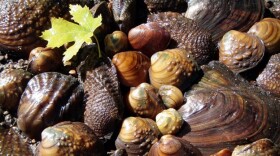The dog days of summer are here. Humid and sticky, but my wood floor looks great! Each hickory flooring strip is pressed tightly against its neighbor. I know this will change. In just a few months, gaps will form along the lengths of the same floorboards. You see, wood is a water loving material. Wood will gain or loose moisture as the relative humidity changes. Wood moves, and it moves a lot!
Let’s start with an example tree such as a sugar maple. When we harvest a sugar maple from the forest, the logs contain a great deal of water. When these logs are sawn into lumber, the resulting lumber is also very wet. The lumber will have around 70% moisture content. This means that the weight of the water in the board is 70% the weight of the oven dry board. Oven dry means all water is removed from the board. Some trees species have moisture contents greater than 100%. This means that the weight of the water in the board is greater than the weight of the oven dry wood.
To be able to use lumber indoors, we need to remove most of the water. By removing water, we make the lumber more useful. Dry lumber is not palatable to most insects or decay fungi, it is lighter, it is stronger, it glues better, it holds screws and nails better, and it is more dimensionally stable.
Lumber producers in Wisconsin use lumber dry kilns to remove water from lumber. If you have ever driven by a sawmill, you may have seen large cube-like buildings, often connected in long rows. These are lumber dry kilns. A typical kiln will hold 40,000 board feet of lumber, and it will take about 10 days to dry one inch thick sugar maple lumber from 70% down to 8% moisture content. 8% moisture content is the industry standard for hardwood lumber used in interior applications. A species like red oak is more difficult to dry and will take up to 30 days in the dry kiln to reach 8% moisture content.
One common misperception held by many is that once lumber is dried to 8% moisture content, the moisture content stays at 8% and never changes. As a wood scientist and a wood worker, I know this is not the case. In fact, wood is a water loving material. You have heard the word hydrophobic, which refers to a person that is afraid of the water or a material that repels water. Wood is just the opposite. It is classified as hydrophilic where water molecules will readily bond to the wood substance.
Back to the lumber dry kiln, suppose we have a charge of sugar maple lumber that was dried to 8% moisture content. If we remove it from the kiln and place it in a shed, what will happen if the weather is very humid? Water vapor in the humid air will bond to the lumber slowly raising its moisture content. What will happen if we ship the lumber to a very dry environment like the Las Vegas dessert? The lumber will give up water to the air lowering its moisture content. As a water loving material, wood will either gain or lose moisture based on the relative humidity of its environment.
I said at the beginning that wood moves a lot. What I meant was that wood shrinks as it loses moisture, and swells as it gains moisture. Let’s go back to the hickory floor in my living room. The boards are tightly fitted during the humid days of August. Humid summer air causes the boards to swell, but not for long. When the gas furnace starts running this fall, the relative humidity will drop, and the hickory floorboards will give up water molecules to the air shrinking in thickness and width causing the gaps to form. These gaps are especially noticeable around the heat registers where warm dry air blows directly on the edges of the flooring.
Your challenge this week is to look at the woodwork in your home and make a mental note of the joints. Revisit those joints in January. How do you think they will change?









